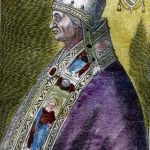Macbeth is the shortest of Shakespeare’s plays and probably the work most associated with that playwright’s well-known sense of imagery. His vivid imagination is also shown hard at work. Hardly a detail in the play’s structure is historically correct, but as in the same writer’s Richard III it really does not matter as the play’s the thing, and though both works might have been composed by a sixteenth century Hollywood scriptwriter, they are towering monuments to the power of the imagination.
Macbeth (the real Macbeth) was the grandson of Malcolm II of Scotland, and therefore no upstart thane scrabbling for the throne. He was also a cousin of Duncan the First, whom he certainly challenged, defeating and killing him on the battlefield at Elgin in August, 1040. There is no evidence that the Macbeths murdered Duncan I in their castle or in anyone else’s.
Before this success Macbeth had been merely the Earl of Moray (a province of Northern Scotland) and had married the gruesomely named Gruoch, whose grandfather had been King Kenneth III. This was the lady destined to enter Shakespeare’s stage as ‘Lady Macbeth’. Macbeth and Gruoch generously supported the Church and actually went on pilgrimage to Rome in 1050.
Our hero was born around 1015. After succeeding his father as Earl, he announced that both he and Duncan derived their rights to the crown through their mothers, and no rule of succession existed that gave either a superior claim.
In 1045 Macbeth won a resounding victory over a rebel army near Dunkeld, Perth. There was a large wood near Dunkeld called Birnam, which may have inspired the Bard to call upon supernatural forces in his Finale, bringing ‘Birnam Wood to Dunsinane’, though the battles are muddled.
In 1046 the Earl of Northumbria was not successful in his attempt to dethrone Macbeth in favour of Malcolm, definitely the favourite candidate of the English to occupy the Scottish throne. The future Malcolm Canmore, Third of Scotland, was a son of Duncan I. He had an ambitious and unreliable brother called Donald Bain or Donalbain.
As previously mentioned, Macbeth felt sufficiently secure in 1050 to leave Scotland for a pilgrimage to Rome. In 1054 however he was apparently forced by Siward, Earl of Northumbria to give up a part of southern Scotland to Malcolm. This enraged him and he fought a combined force of English and Scots at Lumphanan, near Aberdeen on August 15, 1057. He was killed in the battle, but not by anyone called Macduff, a strong figment of Shakespeare’s imagination and writer’s skill.
King Macbeth was buried in the tiny island of Iona off the west coast of Scotland, a burial place of kings but never of usurpers. Actually his stepson was installed by Macbeth’s followers as king but he was eliminated on March 17, 1058 by Malcolm, who in the event turned out to be every bit as bad as Macbeth as portrayed by William Shakespeare. The playwright could easily have written the same play about Malcolm and his awful brother Donalbain. In Roman Polanski’s masterful version of the play he puts an excellent twist in the tale: throughout the film we have seen Macbeth in consultation with the Wicked Sisters in a sinister cave. At the end Macbeth’s head is removed by Macduff, Malcolm becomes King and brother Donalbain rides off to talk with the Wicked Sisters. Why, we wonder?










Leave A Comment